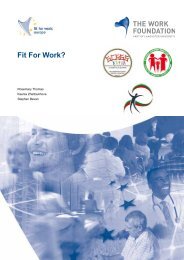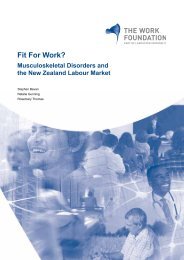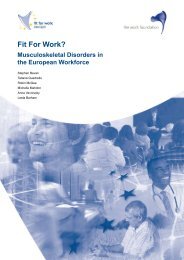English version - Fit for Work Europe
English version - Fit for Work Europe
English version - Fit for Work Europe
Create successful ePaper yourself
Turn your PDF publications into a flip-book with our unique Google optimized e-Paper software.
MSDs and employers<br />
64<br />
lower the morale and self-esteem of injured workers, leading to low engagement, social and<br />
family problems and secondary psychological injuries.<br />
To maximise employees’ capacity when supporting their return to work, we recommend that<br />
employers:<br />
• Intervene early. Employers should always take action sooner rather than later because<br />
caution and delay can only make matters worse. As long as employers behave<br />
compassionately and make decisions based on evidence and expert opinion, early<br />
intervention cannot be construed as harassment and can often hasten recovery or<br />
rehabilitation. Reporting of early signs of illness will help prevent long-term incapacity.<br />
• Implement imaginative job design that will assist rehabilitation. Managers can change<br />
the ways work is organised (including simple changes to working time arrangements)<br />
to help prevent MSDs from getting worse and to help people with MSDs return to work.<br />
Managers need to do this in a way which preserves job quality, avoids excessive job<br />
demands and takes heed of ergonomic good practice. Occupational physicians should<br />
carefully evaluate all aspects – physical and psychosocial – of employee working<br />
environments, taking into consideration both occupational safety and occupational<br />
health aspects.<br />
• Communicate with clinicians. If medical statements are not providing a clear enough<br />
indication of the nature of an employee’s health problem, or its impact on their<br />
capacity to work, occupational physicians should challenge and clarify the clinician’s<br />
assessment, if only to help understand which tasks the employee can still per<strong>for</strong>m,<br />
or what support they might require to return to work. Occupational physicians should<br />
start co-operating with the treating physician immediately after the appearance of the<br />
disability, and begin exchanging medical and occupational health in<strong>for</strong>mation with each<br />
other.<br />
• Include a health and well-being component in managerial awareness-raising and<br />
training. Vocational rehabilitation carefully organised and tailored to the individual<br />
can make a real difference to return to work, productivity, morale and per<strong>for</strong>mance<br />
sustainability. Involve occupational health professionals as early as possible.<br />
• Go beyond legal compliance. A ‘risk management’ mentality when dealing with<br />
an employee with an MSD can often lead to delay, ambiguity and negative health<br />
outcomes. In almost all cases, the employee is better off at work.<br />
<strong>Fit</strong> For <strong>Work</strong>? Musculoskeletal Disorders and the Japanese Labour Market







